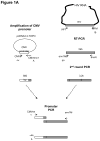The design and validation of a novel phenotypic assay to determine HIV-1 coreceptor usage of clinical isolates
- PMID: 20599562
- PMCID: PMC2930119
- DOI: 10.1016/j.jviromet.2010.06.012
The design and validation of a novel phenotypic assay to determine HIV-1 coreceptor usage of clinical isolates
Abstract
A phenotypic assay to determine coreceptor usage of HIV-1 has been developed for rapid testing of clinical samples. The assay is based on the synthesis of viral stock from full-length env amplicons isolated from patient's plasma. Pseudoviral stock is generated rapidly by using an overlapping PCR method to assemble a CMV promoter to env, followed by co-transfection into producer cells with a HIV plasmid (pNL4-3.Luc.R(-)E(-)) containing a non-functional env. The coreceptor used by the viral quasispecies is tested by infection into U87.CD4.CCR5 and U87.CD4.CXCR4 cells. Viral entry is indicated by the expression of the luciferase gene in relative light units (RLU). The use of CXCR4 coreceptor by minor variants is confirmed with sufficient suppression of RLU by a CXCR4 inhibitor. Two statistical tests are employed to confirm viral entry. This assay accurately assigned coreceptor usage of isolates of various subtypes and in the majority of samples of various viral loads. The sensitivity to detect minor species of CXCR4-using env is 1% at higher viral loads and 5% at less than 1,000 copies/ml. This assay provides a sensitive, efficient and relatively low-cost approach suitable for use by research laboratories for assessing HIV-1 coreceptor usage of plasma samples.
Copyright (c) 2010 Elsevier B.V. All rights reserved.
Figures




Similar articles
-
Development of a rapid cell-fusion-based phenotypic HIV-1 tropism assay.J Int AIDS Soc. 2013 Sep 18;16(1):18723. doi: 10.7448/IAS.16.1.18723. J Int AIDS Soc. 2013. PMID: 24050252 Free PMC article.
-
Linkages between HIV-1 specificity for CCR5 or CXCR4 and in vitro usage of alternative coreceptors during progressive HIV-1 subtype C infection.Retrovirology. 2013 Sep 16;10:98. doi: 10.1186/1742-4690-10-98. Retrovirology. 2013. PMID: 24041034 Free PMC article.
-
Performance of a clonal-based HIV-1 tropism phenotypic assay.J Virol Methods. 2014 Aug;204:53-61. doi: 10.1016/j.jviromet.2014.04.004. Epub 2014 Apr 13. J Virol Methods. 2014. PMID: 24731927
-
Current tests to evaluate HIV-1 coreceptor tropism.Curr Opin HIV AIDS. 2009 Mar;4(2):136-42. doi: 10.1097/COH.0b013e328322f973. Curr Opin HIV AIDS. 2009. PMID: 19339953 Review.
-
HIV coreceptors: from discovery and designation to new paradigms and promise.Eur J Med Res. 2007 Oct 15;12(9):375-84. Eur J Med Res. 2007. PMID: 17933717 Review.
Cited by
-
Genome-Wide Association Study of Human Immunodeficiency Virus (HIV)-1 Coreceptor Usage in Treatment-Naive Patients from An AIDS Clinical Trials Group Study.Open Forum Infect Dis. 2014 May 22;1(1):ofu018. doi: 10.1093/ofid/ofu018. eCollection 2014 Mar. Open Forum Infect Dis. 2014. PMID: 25734091 Free PMC article.
-
Prevalence and clinical associations of CXCR4-using HIV-1 among treatment-naive subtype C-infected women in Botswana.J Acquir Immune Defic Syndr. 2011 May 1;57(1):46-50. doi: 10.1097/QAI.0b013e318214fe27. J Acquir Immune Defic Syndr. 2011. PMID: 21346588 Free PMC article.
-
Development of a rapid cell-fusion-based phenotypic HIV-1 tropism assay.J Int AIDS Soc. 2013 Sep 18;16(1):18723. doi: 10.7448/IAS.16.1.18723. J Int AIDS Soc. 2013. PMID: 24050252 Free PMC article.
-
Differential use of CCR5 by HIV-1 clinical isolates resistant to small-molecule CCR5 antagonists.Antimicrob Agents Chemother. 2012 Apr;56(4):1931-5. doi: 10.1128/AAC.06061-11. Epub 2012 Jan 17. Antimicrob Agents Chemother. 2012. PMID: 22252820 Free PMC article.
-
HIV-1 tropism determination using a phenotypic Env recombinant viral assay highlights overestimation of CXCR4-usage by genotypic prediction algorithms for CRF01_AE and CRF02_AG [corrected].PLoS One. 2013 May 8;8(5):e60566. doi: 10.1371/journal.pone.0060566. Print 2013. PLoS One. 2013. PMID: 23667426 Free PMC article.
References
-
- Braun P, Wiesmann F. Phenotypic assays for the determination of coreceptor tropism in HIV-1 infected individuals. Eur J Med Res. 2007;12:463–72. - PubMed
-
- Coakley E, Reeves JD, Huang W, Mangas-Ruiz M, Maurer I, Harskamp AM, Gupta S, Lie Y, Petropoulos CJ, Schuitemaker H, van 't Wout AB. Comparison of human immunodeficiency virus type 1 tropism profiles in clinical samples by the Trofile and MT-2 assays. Antimicrob Agents Chemother. 2009;53:4686–93. - PMC - PubMed
-
- Cocchi F, DeVico AL, Garzino-Demo A, Cara A, Gallo RC, Lusso P. The V3 domain of the HIV-1 gp120 envelope glycoprotein is critical for chemokine-mediated blockade of infection. Nat Med. 1996;2:1244–7. - PubMed
-
- Fang G, Zhu G, Burger H, Keithly JS, Weiser B. Minimizing DNA recombination during long RT-PCR. J Virol Methods. 1998;76:139–48. - PubMed
Publication types
MeSH terms
Substances
Grants and funding
LinkOut - more resources
Full Text Sources
Medical
Research Materials

